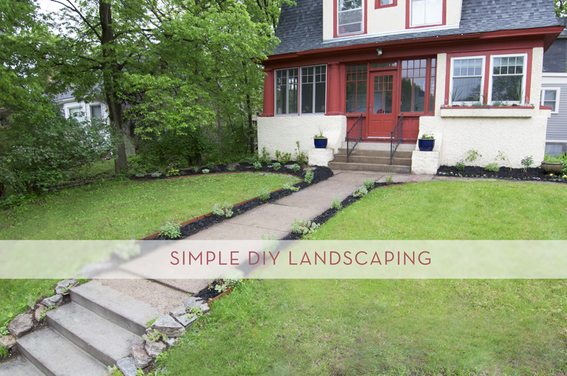The Curbly House has come a long way since we bought it two years ago. From major construction to a whirlwind makeover with the ever-talented Emily Henderson, the interior of the house has been showered with love. But, the outside, not so much.
This spring, we committed ourselves to begin the process of prettying up the outside of our house and creating some much needed curb appeal. While we have a long road ahead that includes having the house painted, a new sidewalk, and new lighting – we wanted to start with the yard, because it’s been neglected for decades.
Here’s a look at the front yard months after we closed on the house:
Aside from a major shrub trim, nothing has changed. In fact, things may have even gotten worse. The patchy lawn seems to be balding at a rapid pace, the weeds are having a heyday, and there is nary a flower in sight.
After much thought and planning, we decided to do a DIY mini-yard makeover with these goals in mind:
- Repair the lawn, making it more lush.
- Extend the garden on the left side of the house to create more visual interest and bring in some much needed texture and color.
- Replant the garden on the right side of the house.
- Add a planted border to the walkway.
- Plant the window box (which up until last week was covered in shingles).
- Replace the concrete planters (they don’t drain) with something more colorful.
Although this was a “mini” makeover to us, the goals felt pretty lofty for our inexperienced gardener genes (we have a hard time keeping succulents alive). We knew we’d need the help of some heavy-duty equipment to get this job done and settled on renting a slit seeder to reseed the lawn. We also rented a sod kicker and rototiller to dig up our new garden area, and a power edger to clean up the lawn’s craggy edges. Renting equipment is a great way to save money, and the amazing thing is, you can rent just about everything under the sun. For a list of rental companies in your area, visit RentalHQ.
Operating machinery like this takes some practice, and we got some great tips from our local Reddy Rents. Watching this slit seeder tutorial and this rototiller how-to helped us learn what to expect from the equipment.
Slit Seeding
The slit seeder was a bit of a beast to operate, simply because it’s heavy and it’s not self propelled. So, pushing it and turning it between passes is a bear. You want to be sure you make two complete passes over your lawn when you slit seed to ensure full coverage. Although the machine took a little muscle to operate, a week after using it, our lawn is looking better than ever.
Sod Kicking and Rototilling
When it came time to build out the garden to the left of our entrance, we used a sod kicker to define the perimeter of the garden bed, and then ran it in strips until all the grass was removed. Then we tilled the soil to help prepare it for new plants.
Planting
After rototilling the area, we edged it with composite plastic edging and covered the garden area with landscape fabric. We then planted the area using a variety of perennials. Because we live in a USDA Hardiness Zone 4 area, we spent a lot of time looking into the best plants to place in our part-sun, part-shade front lawn. We found a great resource on Zone 4 friendly perennials through the University of MN’s Extension program.
We also visited the University’s test garden and snapped a few photos for our idea book. Visiting an arboretum or garden site like this is helpful when planning your garden because all of the plants are labeled, and you get inspired to combine plants in beautiful ways.
We focused on planting perennials that would be visually interesting through all seasons, and carefully chose the following plants:
Flanking the walk:
- Catmint
- Sedum
Shrubs:
- Honeysuckle
- Forsythia
Side Gardens:
- Peonies
- Foamy Bells
- Coralbells
- Sedum
- Ornamental Grass
- Japanese Painted Ferns
- Bleeding Hearts
- Daylilies
Flower Box and Planters:
- Snapdragons
- Lobularias
- Dusty Miller
- Geraniums
- Verbena
- Asparagus
- Ornamental Grass
As we mentioned above, our concrete planters had drainage problems, and although they were lovely, their grey coloring wasn’t doing our entrance any favors. We added drainage to one of them and placed it in our garden, and replaced the set with deep blue ceramic planters.
In addition to planting, we recycled limestone slabs leftover from our house remodel and used them as stepping stones in the garden. We also replaced the willy-nilly, damaged concrete slabs that flanked our boulevard steps with smaller limestone slabs and sedum.
Though it’s still early in the season and the yard needs some time to come into it’s own, this project made a dramatic impact on our house’s curb appeal.
We’ll continue adding new plants, but want to live with the new landscaping for a little while before we add to our work. We’ll update this post with photographs later in the season as we watch our garden grow.
What’s the best tool you’ve rented in your DIY landscaping adventures? What are your favorite landscaping plants? Tell me all about it in the comments below!
This is a sponsored conversation written by me on behalf of American Rental Association. The opinions and text are all mine.

Great work! You have got to be thrilled to finally get started on the outside! Curb appeal is such satisfying work! Congrats!!!
Thanks Tammy! We’re loving it.